|
|
Sarah Doublet's Indian Cave
Littleton Massachusetts
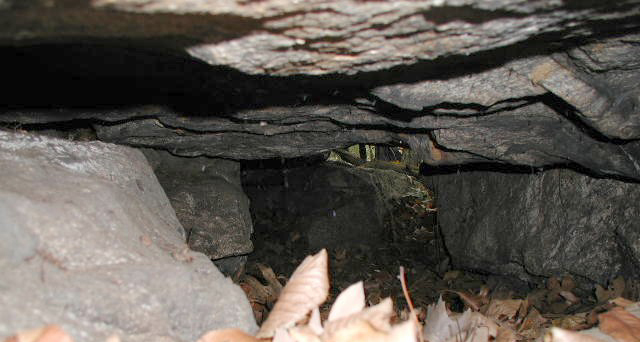
Daniel V. Boudillion ©
14 December 2009
|
Note: this report needs to be read in
context of the article:
Vision Quest and the Nashoba Praying Indian Village
Introduction
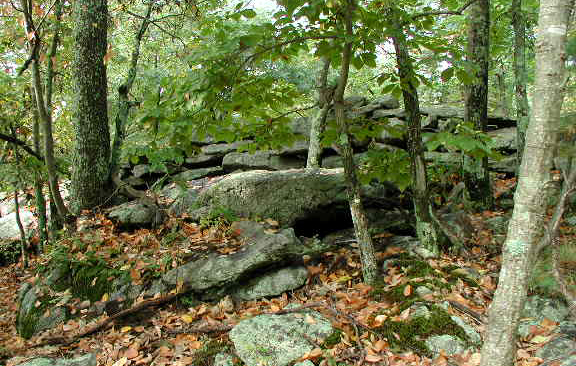 There is an oral tradition in Littleton
that Sarah Doublet (the last Indian to hold title to the 500 Acre
Indian Reservation of 1714) lived in a cave somewhere in what is now the
Sarah Doublet Forest. The problem with this is there was
known cave in the area - indeed, I myself had walked the land
hundreds of times since the late 1970s and did not believe for an
instant there was even the possibility of a cave up there.
Other people I knew wove convoluted theories that her "cave" was
actually a lean-to of branches
up against a large boulder
on the hilltop, for
example. This all changed one Spring morning in
the early 1990s when I was out for a walk in the Sarah Doublet
Forest. There is an oral tradition in Littleton
that Sarah Doublet (the last Indian to hold title to the 500 Acre
Indian Reservation of 1714) lived in a cave somewhere in what is now the
Sarah Doublet Forest. The problem with this is there was
known cave in the area - indeed, I myself had walked the land
hundreds of times since the late 1970s and did not believe for an
instant there was even the possibility of a cave up there.
Other people I knew wove convoluted theories that her "cave" was
actually a lean-to of branches
up against a large boulder
on the hilltop, for
example. This all changed one Spring morning in
the early 1990s when I was out for a walk in the Sarah Doublet
Forest.
Anti-Social Behavior Yields Results
I heard the approach of a large loud
family complete with several rambunctious dogs, and not feeling
quite sociable that morning, I ducked down behind a large tree
growing on a slope next to a stonewall and a mound of ledge-rock,
and snuggled between the tree and the ledge. I noticed that
there was a small opening between the ledge and tree. The
opening was at ground level about 5 inches high and 8 inches wide,
and peering in, I could see into a large dark underground space.
An Underground Chamber
Upon further investigation, the space
proved to be a chamber. The tree had gown up in front of the
door and blocked it entirely except for the small "window" still
open at its base. I would never have seen it had I not been
hunkered down next to it. Indeed, I had actually walked over
the roof slab hundreds of times previously over the years.
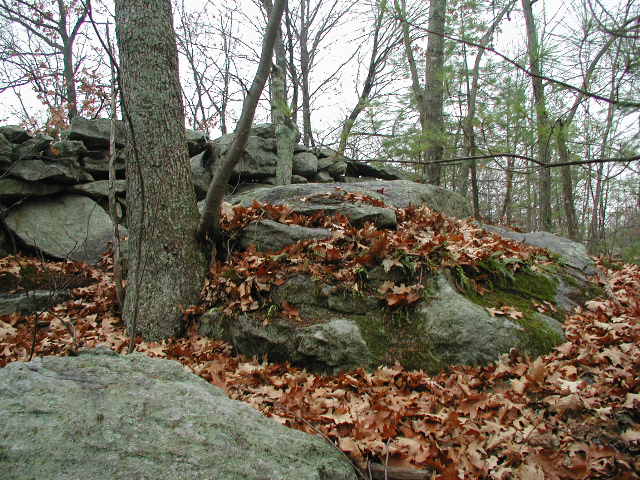
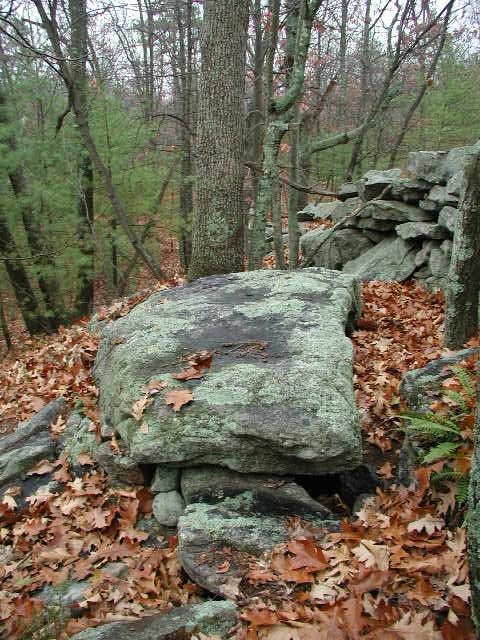
Sarah Doublet's Cave
.
Picture 1:
Note how the tree has grown in front of the chamber door.
Picture 2: Looking down at roof slab
of the chamber. Note the tree at far end of chamber blocking
the door, and the stonework plugging the near end of the chamber.
The far end of the chamber was
constructed with field stone, and I was able to remove some of
this and crawl into it. I found the size to about 8 feet
long, 5 feet wide at its widest point, and about 14 inches high.
Probing with a metal poker reveled that the chamber had filled
with 12 to 14 inches forest detritus, giving a final headspace of
almost 3 feet.
The chamber had been constructed of
ledge slabs. A ledge slab had been pulled away from its
parent rock by about 4 feet, leaving a space between them of about
8 feet long, 4 to 5 feet wide, and 2.5 to 3 feet deep.
Over this another ledge slab had been pulled away from the parent
rock to cover the cavity. This could not have happened
naturally, as the top slab would have fallen into the cavity
rather then cover it. The back end of the cavity was then
carefully blocked up with field stone.
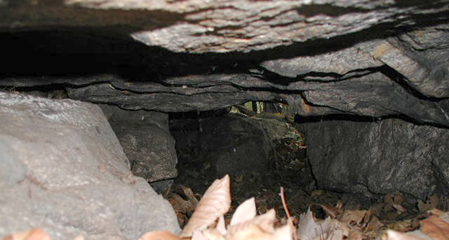
Interior of the Sarah Doublet
Chamber
.
Note:
The hole at the end is the hole I made to gain access to the
chamber. I've since re-built the end.
This is most certainly the "cave"
associated with Sarah Doublet. However, it is not a
structure one can live in (and thus would not have been her
dwelling), but what the tradition of her and the cave actually
does is associate the chamber with Indian activity: it
indicates this is an underground place used by Indians of at least
the Nashoba Praying Indian Plantation era.
A
Vision-Quest Kiva?
Mavor & Dix in Manitou consider
these underground chambers to be "vision-quest" sites, and similar
in placement and use to the Kivas in the American Southwest.
In this respect, the Sarah Doublet Forest chamber need not be
dwelling-sized, but only large enough to comfortably contain a
person for several days of fasting and mediation.
Hilltops & Stone Rows
The chamber is significantly situated
under a dome of ledge that is the highest point of the Sarah
Doublet Forest. The entrance of the chamber faces Southeast
in the general direction of the Winter Solstice Sunrise. The
entire hill is only recently grown over with scrub oak and pines.
Previous to this it was open and heath-like. Indeed, it was
open enough that as recently as the early 1980s I can recall being
able to see at sunset both the moon rising on the eastern horizon
while and the sun slipped below the low western hills. (The
entire hill showed signs of being burned over, and it is possible
this followed a practice the Indians were known to have used.)
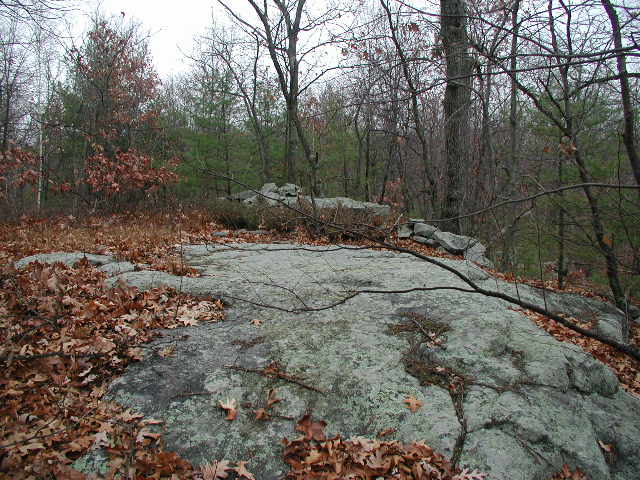
Dome of Bedrock: Highest point in
the Sarah Doublet Forest
.
Note:
The chamber is under the dome.
Further, there is a stone row that runs
over the top of the chamber. Interestingly, at the point it
runs over the chamber dome, and in several dozen feet in either
direction, it is composed of exceedingly large slabs of rock.
It also follows the contours of the ledge rather then running in a
straight line, and makes bridges over gaps in the ledge-face.
However, if followed further in either direction, the row-rocks
diminish into regular Colonial-style stonework and follow regular
Colonial-style straight lines.
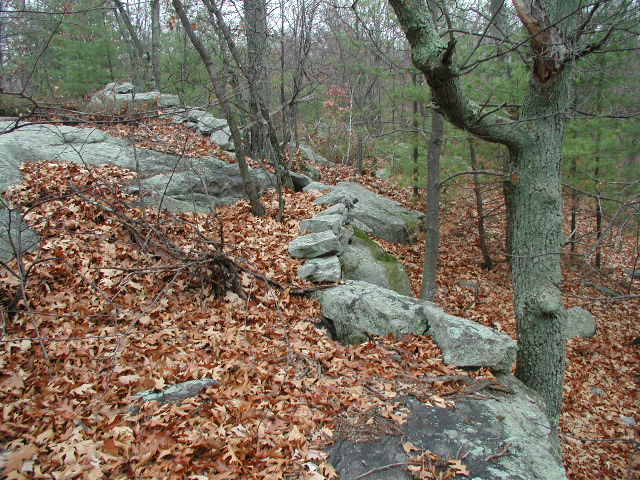
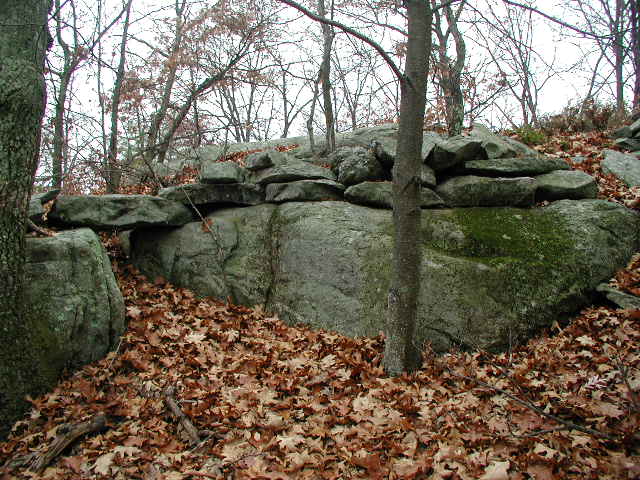
The Stone Row at the Sarah
Doublet Chamber
.
Picture 1:
Note how the stone row follows contours of the ledge above the
chamber. Picture 2: Note how
the stone row makes a bridge between ledge-rocks.
The chamber itself is a cavity in a
granite ledge, covered with a granite slab. Considering that
granite is a radon-bearing rock, and radon gas awareness is a
health issue in Littleton, it stands to reason that radon
poisoning - or more precisely its possible effects - may have
contributed to vision-quest experience in the small Sarah Doublet
Chamber.
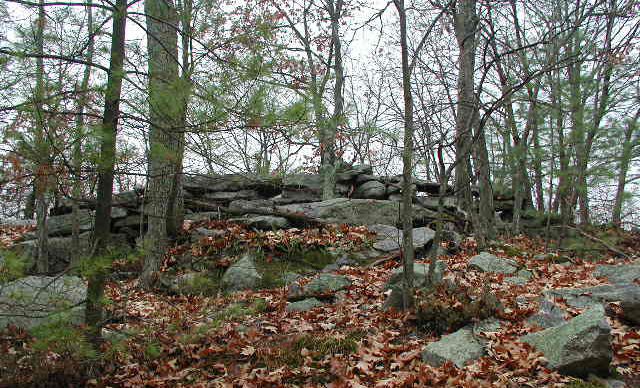
Stone Row & Chamber
.
Picture 1:
Note how the stone row goes over the top of the chamber which is
at the top of the hill.
.
Of Monks & Mediation
Indeed, Indians are not the only ones
who find the hill spiritually attractive. Its not uncommon
to stumble upon a quiet soul perched upon a rock in mediation, and
the monks from the Westford Lamasery are also seen here on
occasion. And perhaps most significantly from the
perspective of pagan Indian rituals, it is known that modern
neo-Pagans constructed a
stone circle on the dome and worshipped
Nature there for years.
Back to
Nashoba Hill: The Hill that Roars
Email Daniel V.
Boudillion
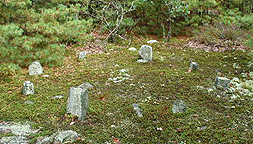
Back to Field
Journal
Copyright © 2009 by Daniel V. Boudillion
| 








